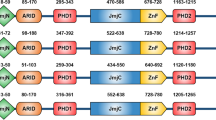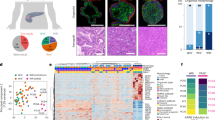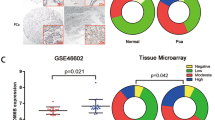Abstract
Definitive endoderm differentiation is crucial for generating respiratory and gastrointestinal organs including pancreas and liver. However, whether epigenetic regulation contributes to this process is unknown. Here, we show that the H3K27me3 demethylases KDM6A and KDM6B play an important role in endoderm differentiation from human ESCs. Knockdown of KDM6A or KDM6B impairs endoderm differentiation, which can be rescued by sequential treatment with WNT agonist and antagonist. KDM6A and KDM6B contribute to the activation of WNT3 and DKK1 at different differentiation stages when WNT3 and DKK1 are required for mesendoderm and definitive endoderm differentiation, respectively. Our study not only uncovers an important role of the H3K27me3 demethylases in definitive endoderm differentiation, but also reveals that they achieve this through modulating the WNT signaling pathway.
Similar content being viewed by others
Log in or create a free account to read this content
Gain free access to this article, as well as selected content from this journal and more on nature.com
or
References
Murry CE, Keller G . Differentiation of embryonic stem cells to clinically relevant populations: lessons from embryonic development. Cell 2008; 132:661–680.
Zorn AM, Wells JM . Vertebrate endoderm development and organ formation. Annu Rev Cell Dev Biol 2009; 25:221–251.
Schier AF . Nodal morphogens. Cold Spring Harb Perspect Biol. 2009; 1:a 003459.
D'Amour KA, Agulnick AD, Eliazer S, Kelly OG, Kroon E, Baetge EE . Efficient differentiation of human embryonic stem cells to definitive endoderm. Nat Biotechnol 2005; 23:1534–1541.
Kubo A, Shinozaki K, Shannon JM, et al. Development of definitive endoderm from embryonic stem cells in culture. Development 2004; 131:1651–1662.
Mfopou JK, Chen B, Sui L, Sermon K, Bouwens L . Recent advances and prospects in the differentiation of pancreatic cells from human embryonic stem cells. Diabetes 2010; 59:2094–2101.
Osafune K, Caron L, Borowiak M, et al. Marked differences in differentiation propensity among human embryonic stem cell lines. Nat Biotechnol 2008; 26:313–315.
Martin C, Zhang Y . The diverse functions of histone lysine methylation. Nat Rev Mol Cell Biol 2005; 6:838–849.
Cao R, Zhang Y . The functions of E(Z)/EZH2-mediated methylation of lysine 27 in histone H3. Curr Opin Genet Dev 2004; 14:155–164.
Agger K, Cloos PA, Christensen J, et al. UTX and JMJD3 are histone H3K27 demethylases involved in HOX gene regulation and development. Nature 2007; 449:731–734.
De Santa F, Totaro MG, Prosperini E, Notarbartolo S, Testa G, Natoli G . The histone H3 lysine-27 demethylase Jmjd3 links inflammation to inhibition of polycomb-mediated gene silencing. Cell 2007; 130:1083–1094.
Lan F, Bayliss PE, Rinn JL, et al. A histone H3 lysine 27 demethylase regulates animal posterior development. Nature 2007; 449:689–694.
Lee MG, Villa R, Trojer P, et al. Demethylation of H3K27 regulates polycomb recruitment and H2A ubiquitination. Science 2007; 318:447–450.
Lee S, Lee JW, Lee SK . UTX, a histone H3-lysine 27 demethylase, acts as a critical switch to activate the cardiac developmental program. Dev Cell 2012; 22:25–37.
Satoh T, Takeuchi O, Vandenbon A, et al. The Jmjd3-Irf4 axis regulates M2 macrophage polarization and host responses against helminth infection. Nat Immunol 2010; 11:936–944.
Pan G, Tian S, Nie J, et al. Whole-genome analysis of histone H3 lysine 4 and lysine 27 methylation in human embryonic stem cells. Cell Stem Cell 2007; 1:299–312.
Zhao XD, Han X, Chew JL, et al. Whole-genome mapping of histone H3 Lys4 and 27 trimethylations reveals distinct genomic compartments in human embryonic stem cells. Cell Stem Cell 2007; 1:286–298.
Bernstein BE, Mikkelsen TS, Xie X, et al. A bivalent chromatin structure marks key developmental genes in embryonic stem cells. Cell 2006; 125:315–326.
Zhang D, Jiang W, Liu M, et al. Highly efficient differentiation of human ES cells and iPS cells into mature pancreatic insulin-producing cells. Cell Res 2009; 19:429–438.
Nostro MC, Sarangi F, Ogawa S, et al. Stage-specific signaling through TGFbeta family members and WNT regulates patterning and pancreatic specification of human pluripotent stem cells. Development 2011; 138:861–871.
Wang P, Rodriguez RT, Wang J, Ghodasara A, Kim SK . Targeting SOX17 in human embryonic stem cells creates unique strategies for isolating and analyzing developing endoderm. Cell Stem Cell 2011; 8:335–346.
Davidson KC, Adams AM, Goodson JM, et al. Wnt/beta-catenin signaling promotes differentiation, not self-renewal, of human embryonic stem cells and is repressed by Oct4. Proc Natl Acad Sci USA 2012; 109:4485–4490.
D'Amour KA, Bang AG, Eliazer S, et al. Production of pancreatic hormone-expressing endocrine cells from human embryonic stem cells. Nat Biotechnol 2006; 24:1392–1401.
Kim SW, Yoon SJ, Chuong E, et al. Chromatin and transcriptional signatures for Nodal signaling during endoderm formation in hESCs. Dev Biol 2011; 357:492–504.
Acknowledgements
We thank our colleagues in our lab: Dr Jin He for help in lentiviral transfection and providing the mouse Kdm6b cDNA and mutant constructs; Dr Shinpei Yamaguchi for making Figure 5; Drs Jin He and Gaoyang Liang for critical reading of the manuscript. This work is supported by U01DK089565 from NIH. YZ is an Investigator of the Howard Hughes Medical Institute.
Author information
Authors and Affiliations
Corresponding author
Additional information
( Supplementary information is linked to the online version of the paper on the Cell Research website.)
Supplementary information
Supplementary information, Figure S1
Definitive endoderm is successfully induced in human ESC line HUES8. (PDF 3443 kb)
Supplementary information, Figure S2
RT-qPCR quantification of knockdown efficiency of the stable KDM6A (left) and KDM6B (right) knockdown HUES8 cell lines. (PDF 188 kb)
Supplementary information, Figure S3
KDM6A/KDM6B knockdown cells exhibit impaired endoderm differentiation during the entire differentiation process. (PDF 5172 kb)
Supplementary information, Figure S4
KDM6A or KDM6B knockdown does not affect ESC maintenance (PDF 3317 kb)
Supplementary information, Figure S5
DAVID-KEGG (http://david.abcc.ncifcrf.gov">) signaling pathway analysis with the overlapped H3K27me3-marked genes in human ESCs from two independent reports (Pan et al. 2007; Zhao et al. 2007). (PDF 461 kb)
Supplementary information, Figure S6
RT-qPCR quantification of knockdown efficiency of the stable WNT3 (left) and DKK1 (right) knockdown HUES8 cell lines. (PDF 157 kb)
Supplementary information, Figure S7
KDM6A/KDM6B knockdown alters WNT target gene expression under definitive endoderm differentiation conditions. (PDF 235 kb)
Supplementary information, Table S1
Primers for quantitative expression analysis of RT-PCR. (PDF 106 kb)
Supplementary information, Table S2
Genomic primers for ChIP-qPCR. (PDF 81 kb)
Supplementary information, Data S1
Methods (PDF 128 kb)
Rights and permissions
About this article
Cite this article
Jiang, W., Wang, J. & Zhang, Y. Histone H3K27me3 demethylases KDM6A and KDM6B modulate definitive endoderm differentiation from human ESCs by regulating WNT signaling pathway. Cell Res 23, 122–130 (2013). https://doi.org/10.1038/cr.2012.119
Received:
Revised:
Accepted:
Published:
Issue date:
DOI: https://doi.org/10.1038/cr.2012.119
Keywords
This article is cited by
-
A desert lncRNA HIDEN regulates human endoderm differentiation via interacting with IMP1 and stabilizing FZD5 mRNA
Genome Biology (2023)
-
The H3K27 demethylase controls the lateral line embryogenesis of zebrafish
Cell Biology and Toxicology (2023)
-
Stepwise differentiation of functional pancreatic β cells from human pluripotent stem cells
Cell Regeneration (2022)
-
KDM6B cooperates with Tau and regulates synaptic plasticity and cognition via inducing VGLUT1/2
Molecular Psychiatry (2022)
-
The ERα/KDM6B regulatory axis modulates osteogenic differentiation in human mesenchymal stem cells
Bone Research (2022)



